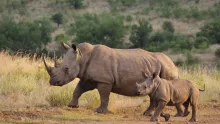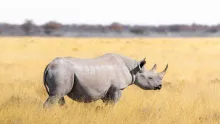Skip to main content
General Information
- The Moose (Alces alces) is the largest species of deer in the world.
- It is native to North America, Europe, and Asia, thriving in boreal forests.
- Moose are solitary animals and do not form herds like other deer species.
- They are strong swimmers and often inhabit areas near lakes, rivers, and wetlands.
- Moose are herbivores, feeding on leaves, twigs, bark, and aquatic plants.
Physical Chara
General Information
- The Mule Deer (Odocoileus hemionus) is a species of deer native to North America.
- It is named for its large ears, which resemble those of a mule.
- Mule deer are found in western North America, including the U.S., Canada, and Mexico.
- They are herbivores, primarily feeding on leaves, shrubs, and grasses.
- Mule deer are well known for their unique bounding gait, called "stotting," where they leap with all
General Information
- The Red Deer (Cervus elaphus) is one of the largest deer species in the world.
- It is native to Europe, North Africa, and parts of Asia but has been introduced to other regions.
- Red deer are known for their majestic antlers, which are found only in males.
- They are herbivores, primarily feeding on grass, leaves, and shrubs.
- Red deer play an important role in forest ecosystems by helping with seed dispersal and vegetatio
General Information
- The Hippopotamus (Hippopotamus amphibius) is a large, semi-aquatic mammal native to Africa.
- It is the third-largest land mammal after the elephant and rhinoceros.
- Hippos are known for their aggressive nature and are considered one of the most dangerous animals in Africa.
- They are herbivores, feeding mainly on grass.
- Hippos are primarily found in rivers, lakes, and swamps of sub-Saharan Africa.
Introduction
- The Indian Rhinoceros (Rhinoceros unicornis), also known as the Greater One-Horned Rhinoceros, is one of the largest rhino species.
- They are known for their single horn and armor-like skin folds, which give them a prehistoric appearance.
- Indian Rhinos are native to the Indian subcontinent and are primarily found in protected areas.
Physical Characteristics
- Indian Rhinos have a massive, robust body,
General Information
- The White Rhinoceros (Ceratotherium simum) is the largest species of rhinoceros.
- It is native to Africa, primarily found in South Africa, Namibia, Zimbabwe, and Kenya.
- White rhinos are divided into two subspecies: the Southern White Rhino and the Northern White Rhino.
- The Northern White Rhino is functionally extinct, with only two known individuals remaining.
- The species is classified
Introduction
- The Black Rhinoceros (Diceros bicornis) is one of the two African rhinoceros species, the other being the White Rhinoceros.
- They are known for their prehensile upper lip, which helps them grasp leaves and twigs.
- Black Rhinos are critically endangered due to poaching and habitat loss.
Physical Characteristics
- Black Rhinos have a stocky, robust body, with males weighing between 1,800 to 3,100 pounds (800 to 1,400 kg) and females slig
General Information
- The Asian Elephant (Elephas maximus) is the largest land mammal in Asia.
- They are found in India, Sri Lanka, Nepal, Thailand, and other Southeast Asian countries.
- Asian elephants are smaller than African elephants and have a domed head and smaller ears.
- They have a lifespan of 60 to 70 years in the wild.
Diet and Habitat
- Asian elephants are herbivores that consume
Introduction
- The Giraffe (Giraffa camelopardalis) is the tallest land animal on Earth.
- They are known for their long necks, long legs, and distinctive coat patterns.
- Giraffes are native to Africa and are found in savannas, grasslands, and open woodlands.
Physical Characteristics
- Giraffes have a tall, slender body, with males standing up to 18 feet (5.5 meters) tall and females slightly shorter.
- Their co
Introduction
- The African Elephant (Loxodonta africana) is the largest land animal on Earth.
- They are known for their massive size, long trunks, and large ears.
- African Elephants are highly intelligent and social animals, living in complex matriarchal herds.
Physical Characteristics
- African Elephants have a massive, robust body, with males weighing between 10,000 to 14,000 pounds (4,500 to 6,300 kg) and females slightly smaller.
- Their sk










